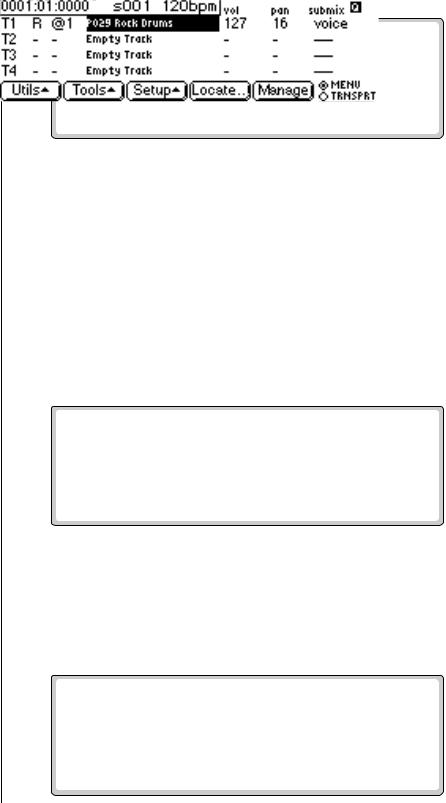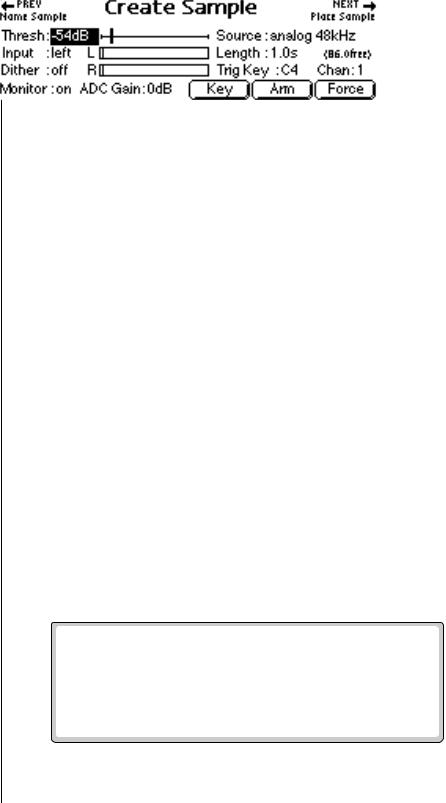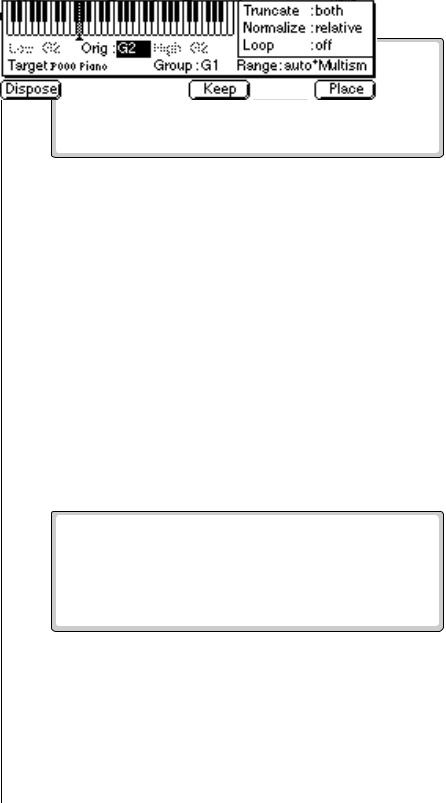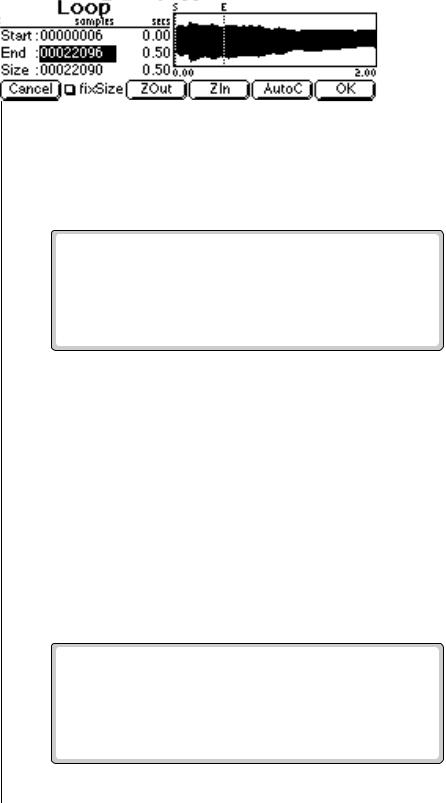
- •Contents
- •Introduction
- •Introduction
- •Important Upgrade Information
- •About EOS
- •Graphic User Interface
- •Sequencer and Data Filer
- •Sound Libraries
- •Sound Storage
- •Advanced DSP
- •Built-in Digital Effects
- •More Digital Processing Features
- •Power Up!
- •Loading a Bank from the Hard Disk
- •Loading SoundSprints
- •Selecting Presets
- •Lock Button
- •Saving
- •Arpeggiator
- •Keyboard Modes
- •Whole
- •Layer
- •Split
- •Multi
- •The Basics
- •How Sounds are Organized
- •The Sample
- •Voices
- •The Preset
- •SoundSprint
- •Bookmarks
- •The Bank
- •Folders
- •The Internal Drive
- •To Update the EOS Software:
- •External Drives
- •Sample Memory & Preset Memory
- •Sound ROM & Sound RAM
- •Five Types of Memory
- •Flash Sound RAM
- •Sample Numbers
- •Using Preset Flash Memory
- •Using Sound Flash Memory
- •Modules
- •Saving
- •Default
- •Icons
- •The Cursor
- •Data Entry Control & Increment/Decrement Buttons
- •Selecting
- •Using The Browser
- •Guided Tours
- •Banks, Sequences, Presets & Samples
- •Loading a Bank Automatically
- •Loading a Sequence from a Different Bank
- •Loading Standard MIDI Files
- •Saving Banks
- •Finding Banks, Presets, Samples & Sequences
- •Naming Banks
- •Erasing Banks
- •Assignable Keys
- •Recording a Sequence
- •Arpeggiator Sequencing!
- •A Practice Sampling Session
- •Exploring the Preset
- •Which Voices are Assigned to the Keyboard?
- •Creating a Link
- •Master Menu
- •Overview
- •Memory Statistics
- •Master Utilities
- •Assignable Keys
- •Channel Volume
- •Tones
- •Recalibration
- •Test Access
- •About…
- •Bank
- •Erase Bank
- •Name Bank
- •Auto Bank Load
- •Flash Utilities
- •Using Sound Flash Memory
- •Erase the Bank
- •Load the Bank you Wish to Save to Flash
- •Save the Sounds to Flash
- •Mount the Drive
- •Erase the Bank…again
- •Erase Preset 000
- •Merge the Presets
- •Save the Presets
- •Setup
- •Tune
- •Tuning Offset
- •Transpose
- •Audition Key
- •Input/Output
- •Headroom
- •Output Boost
- •Output Format
- •ADAT Output Dither
- •Default Clock
- •Word Clock In
- •WC Phase In/Out
- •Miscellaneous
- •Contrast
- •Wrap Field Selection
- •Screen Saver
- •Disable Sound ROM
- •Zero Crossing Threshold
- •Background
- •Undo/Redo Enable
- •SCSI/Disk
- •SCSI ID
- •SCSI Termination On/Off
- •Avoid Host on ID
- •Disk Button Goes To:
- •Import Options
- •Master Effects
- •Use Master Effects Settings in MultiMode
- •Master Effects A
- •A EFFECT TYPES
- •Master Effects B
- •B EFFECT TYPES
- •Effects Setup
- •Effects Control
- •Sequence Manage
- •MIDI
- •MIDI Mode
- •Basic Channel
- •MIDI Mode
- •MIDI Device ID
- •Local Control
- •Multimode - MIDI Mix
- •MIDI Controllers
- •About MIDI Controllers
- •MIDI Preferences
- •Velocity Curve
- •Controller #7 Sensitivity
- •Controller #7 Curve
- •Global Pedal Override
- •Receive Program Change On/Off
- •Send Program Change On/Off
- •Magic Load Preset
- •Effects
- •Effects
- •Dual Effects Processor
- •The Effects Sends
- •Effect B Into Effect A
- •Three-way Effects Control
- •Effects Programmed in the Preset
- •Master Effects
- •Using Master Effects Settings in Multimode
- •Using the Effects Channel Settings in Multimode
- •Effects Bypass
- •Effect Descriptions
- •A EFFECT TYPES
- •B EFFECT TYPES
- •Reverb
- •General Descriptions of Reverb
- •Chorus
- •Doubling
- •Slapback
- •Stereo Flanger
- •Delay
- •Stereo Delay
- •Panning Delay
- •Dual Tap
- •Vibrato
- •Distortion
- •Sequencer
- •Sequence Manage
- •Recording MIDI SysEx
- •Important Information for Loading Standard MIDI Files
- •Name Sequence
- •Export
- •Transport Controls
- •Sequencer Utilities
- •Erase
- •Copy Sequence
- •Sequencer Memory
- •Jukebox
- •Sequence Edit
- •The Sequence Edit Screen
- •Track Mode
- •Track Numbers
- •Counter Display
- •Tempo Display
- •MIDI Channel Modes
- •Volume - Pan - Submix
- •The Initial Track State Screen
- •Initial Tempo
- •Editing: Cut, Copy & Paste
- •Cut/Copy/Erase
- •Note Erase
- •Erase
- •Delete
- •Paste
- •Insert
- •Replace
- •Track Delete
- •Track Copy
- •UNDO! (REDO!)
- •Tools
- •Quantize
- •Quantize -1/4 Note
- •Quantize - 8th Notes, Swing 60%
- •Quantize - 8th Notes, Swing 67%
- •Quantize - 8th Notes, Swing 75%
- •Transpose
- •Sequence Velocity
- •Channelize
- •Channel Extract
- •Setup
- •Metronome
- •Sequence Clock
- •Sequence Input
- •Sequence Record
- •Start Record -
- •Count In
- •Sequence Loop
- •Transport
- •Track Status Options:
- •Received MMC Commands
- •Locate
- •Sample Manage
- •Overview
- •Sample Utilities
- •Erase Sample
- •Copy Sample
- •Sample Dump
- •Defragment Memory
- •Name Sample
- •New Sample
- •Threshold
- •Input Channels
- •Sampling Source & Rate
- •Dither
- •ADC Gain
- •Sample Length
- •Arm Sample Trigger
- •Force Sample Trigger
- •Keyboard Sample Trigger
- •Monitor On/Off
- •Automatic Parameters
- •Automatic Digital Signal Processing Operations
- •Auto-Placement Parameters
- •Place Sample
- •Export Sample
- •Get Info
- •Sample Edit
- •Sample Edit
- •Background: The Scrub Wheel
- •Background: Using Cut, Copy, Paste and Undo
- •Undo and Redo
- •Typical Applications
- •Background: About Looping
- •How Looping Works
- •Auto Correlation
- •Creating Attack & Decay Characteristics for the Looped Portion
- •Loop Compression
- •Crossfade Looping
- •Zero Crossing
- •Utilities
- •Cut Section
- •Copy Section
- •Paste Section
- •Truncation
- •Taper
- •Tools 1
- •Loop
- •Loop Type
- •Digital Tuning
- •Sample Rate Convert
- •Sample Calculator
- •Tools 2
- •DC Filter
- •Swap Left & Right
- •Stereo <-> Mono
- •Reverse Section
- •Sample Integrity
- •Tools 3
- •Gain Change
- •Compressor
- •Mode
- •Threshold
- •Compression Ratio
- •Attack Time
- •Release Time
- •Using the Digital Compressor
- •Limiter
- •Musical Compression (e.g. Guitar)
- •Noise Reduction
- •Parametric Equalizer
- •FIR (Phase Linear Filter)
- •Aphex Aural Exciter
- •Tools 4
- •Transform Multiplication
- •Doppler
- •Time Compression
- •Pitch Change
- •Bit Converter
- •Beat Munger
- •Beat Munger Controls
- •Undo
- •Preset Manage
- •Preset Manage
- •Utilities
- •Erase Preset
- •Dump Preset
- •Name Preset
- •New Preset
- •Copy Preset
- •Export Preset
- •Get Info
- •Preset Edit
- •Synthesizer Basics
- •Editing Presets
- •Modulation
- •Modulation Sources
- •Keyboard Key
- •Key Velocity
- •Release Velocity
- •Gate
- •Key Glide
- •Pitch and Mod Wheels
- •Keyboard Pressure (mono aftertouch)
- •Pedal
- •Miscellaneous Controllers A -H
- •Low Frequency Oscillators (2 per voice)
- •Envelope Generators (3 per voice)
- •Noise & Random Generators
- •Thumby Button and Footswitches
- •Modulation Cords
- •Envelope Generators
- •Low Frequency Oscillators (LFOs)
- •Random Sources
- •Clock Modulation
- •Syncing an LFO to the Clock
- •Modulation Destinations
- •Modulation Processors
- •Modulation Processors
- •Dynamic Filters
- •Dynamic Filters
- •What is a Filter?
- •Parametric Filters
- •The Z-Plane Filter
- •Selecting Voices, Samples & Groups
- •Selecting from the Preset Editor Windows
- •Selecting All Voices
- •Selecting Voices from the Dynamic Processing Level
- •Selecting Voices from the Voice Select Screen
- •Groups
- •Preset Editor
- •PRESET EDIT - Global
- •Global Editor
- •Edit All
- •Preset Effects A
- •Effects Programmed in the Preset
- •Effect
- •A EFFECT TYPES
- •Decay Time
- •HF Damping
- •FX Amounts
- •FX B Through FX A
- •Preset Effects B
- •Effect B
- •B EFFECT TYPES
- •Feedback Amount
- •LFO Rate
- •Delay Time
- •FX Amounts
- •Preset Edit - Links
- •Main Controls
- •Link Type
- •Link Volume
- •Link Pan
- •Link Transpose
- •Link Fine Tuning
- •Link Utilities
- •New Link
- •Copy Link
- •Delete Link
- •Subsume Link
- •Links - Key Window
- •Key Window Controls
- •Keyboard & Velocity Ranges
- •Links - Velocity Window
- •Velocity Window Controls
- •Velocity Range
- •Links - MIDI Filters
- •MIDI Filter Window Controls
- •Preset Edit - Voices
- •Voices - Main Controls
- •Voice Utilities
- •New Voice
- •Copy Voice
- •Delete Voice
- •Split Voice
- •Solo Voice
- •Sample Zone
- •New Sample Zone
- •Get Multisample
- •Delete Sample Zone
- •Combine
- •Expand...
- •Voices - Key Window
- •Key Window Controls
- •Keyboard Ranges
- •Voices -Velocity Window
- •Velocity Window Controls
- •Velocity Range
- •Voices - Realtime Window
- •Realtime Window Controls
- •Preset Edit - Dynamic Processing Level
- •Utilities
- •Voice Select
- •Function Keys
- •The Isolate Key:
- •Copy Voice(s)
- •Delete Voice(s)
- •Automatic Voice Selection
- •WARNING!
- •Solo Voice
- •Key Transpose
- •Coarse Tuning
- •Fine Tuning
- •Non-transpose Mode
- •Chorus Amount
- •Delay
- •Start Offset
- •Glide Rate & Curve
- •Solo Modes
- •Latch Mode
- •Assign Group
- •Filter Parameters
- •FILTER TYPES
- •2-Pole Lowpass
- •4-Pole Lowpass
- •6-Pole Lowpass
- •2nd Order Highpass
- •4th Order Highpass
- •2nd Order Bandpass
- •4th Order Bandpass
- •Contrary Bandpass
- •Swept EQ, 1-octave
- •Swept EQ, 2->1-octave
- •Swept EQ, 3->1-octave
- •Phaser 1
- •Phaser 2
- •Bat Phaser
- •Flanger Lite
- •Vocal Ah-Ay-Ee
- •Vocal Oo-Ah
- •Dual EQ Morph
- •2EQ + Lowpass Morph
- •2EQ Morph + Expression
- •Peak/Shelf Morph
- •Filter Envelope
- •LFO/Auxiliary Envelope
- •Lag Processors
- •Auxiliary Envelope
- •Cords
- •Sample Retrigger
- •Disk Menu
- •Disk Menu
- •Disk Browser
- •Disk
- •Disk Utilities
- •Mount Drives
- •Copy System
- •Format Disk
- •Low Level Format
- •Backup
- •Load Bank
- •Note:
- •Save Bank
- •View…
- •Info, Lock Drive, & Sleep
- •Lock
- •Sleep
- •Folder Utilities
- •Delete
- •Rename
- •Find…
- •View
- •Info…
- •Bank
- •Bank Utilities
- •Delete
- •Name
- •Find…
- •Load Bank
- •Save Bank
- •View
- •Info…
- •Preset
- •Preset Utilities
- •Soundsprint™
- •Bookmarks
- •Find…
- •Load Preset
- •View
- •Info…
- •Sample
- •Sample Utilities
- •Find...
- •View
- •Load Sample
- •Load .WAV & AIFF Files
- •Audition
- •Info…
- •Sequence
- •Sequence Utility
- •Find…
- •View
- •Load Sequence
- •Info…
- •Important Information for Loading Standard MIDI Files
- •Appendix
- •SCSI
- •Why Use SCSI?
- •The SCSI Bus
- •ID Numbers
- •Types of SCSI Cables
- •Terminating SCSI Cables
- •SCSI Problems
- •Sample Transfers Via SMDI
- •Using Multiple Samplers on the SCSI Bus
- •MIDI
- •MIDI Implementation Chart
- •Notes:
- •Index

1 - The Basics
Arpeggiator Sequencing!
v Record Track 1
23.Press the Menu/Transport function key (F6). The Transport control buttons appear on the lower line of the display.
24.Get ready to record! Press the Record function key (F4).
25.Press the Play function key (F3) to begin recording. You should be hearing the metronome.
26.Start playing. If you make a serious mistake in your playing and want to try again, press Abort (F5). Then press Record, then Play to begin again.
27.Press the Stop function key (F2) to end recording. Press RTZ (F1) to rewind to the beginning of the sequence. Press Play (F3) to play back your creation.
•Note that the Track Status field for Track 1 now reads P for playback. The track can also be set to M to Mute the track if you don't want to hear it.
v Record Another Track
28.Set Track 2 to Record. Move the cursor to the record field of track 2 and set the track to R (record).
29.Move the cursor to the channel field of track 2 and set the channel to @2. This will force all information onto MIDI channel 2.
30.Move the cursor back to the preset field on track 2 and select a preset.
31.You’re ready to record track 2. Follow the instructions for recording on track 1 and GO!
Arpeggiator Sequencing!
One of the many things you can do with EOS is combine the Arpeggiator and the Sequencer. This is a great idea stimulator and tons of fun.
v Load a Bank of Sounds (E-Synth - jump to step 5)
1.From the main screen press the Load function key (F4).
2.Select the desired Folder and Bank.
3.Press the Load function key (F6).
4.The display informs you that you are about to overwrite the current bank. Press OK (F6) to load the bank.
v Select Multimode
5.From the main screen press the Mode function key (F6).
6.Select Multi (F6). The following screen appears.
50 E-MU Systems

1 - The Basics
Arpeggiator Sequencing!
There are two different Multimode screen views. If you get the other screen, press the key (F6), then press View (F3).
v Set Keyboard to Channel 1
7.If you are using an E-Synth keyboard or an E4K, select channel 1 and press SetBCh (Set Basic Channel). If you are using an external MIDI keyboard, set it to transmit on channel 1.
v Select a Preset
8.Move the cursor to the preset field and select a preset. Turn on the Arpeggiator.
9.Press the Mode function key (F6).
10.Select Arp (F5). The Multimode Arpeggiator screen appears.
11.The Arpeggiator will be on. While playing the keyboard select a Preset using the Data Entry Control, INC/DEC buttons or the numeric keypad.
12. Adjust the Arpeggiator controls until you have a nice groove going.
vEnter the Sequencer Submodule
E-Synth Keyboard and 13. Press the Seq function key (F1) from the main preset screen. The
E4K have dedicated Sequencer |
|
Sequence Manage screen appears. |
|
buttons. |
14. |
Press the Edit function key (F5). The Edit screen appears. |
|
|
|||
|
|
|
|
|
|
|
|
EOS 4.0 Software Manual 51

1 - The Basics
Arpeggiator Sequencing!
O Since you've already selected a preset for MIDI channel 1 in Multimode, the preset will automatically come up when you set @1 as the channel number.
v Setup Track 1 for Recording
Almost ready to start recording…
15.Set the Track Mode to Record. Move the cursor to the Track Mode location as shown above. Set this field to R (Record) using the Increment button or Data Entry Control.
16.Move the cursor right to the Channel field. Set the channel to @1 using the Inc/Dec buttons or Data Entry Control. The @1 function records on MIDI channel 1 exclusively.
17.Play the keyboard. You should be hearing the arpeggiator playing the preset you selected.
v Record Track 1
18.Press the Menu/Transport function key (F6). The Transport control keys appear on the lower line of the display.
19.Get ready to record! Press Record (F4), then Play (F3) to begin recording.
20.Start playing.
21.Press Stop (F2) to end recording. Press RTZ (F1) to rewind to the beginning of the sequence. Press Play (F3) to play back your creation.
v Turn the Arpeggiator Off
22.Note that the arpeggiated sequence is being arpeggiated again! Press the Stop function key (F2), then press the Exit button to return to the Multimode screen.
23.Press the Mode function key (F6).
24.Select Arp (F5). The Multimode Arpeggiator screen appears.
25.Press Stop (F2) to stop the arpeggiator.
26.Press OK (F6) or Done (F1) to return to the Multimode screen.
v Back to the Sequencer…
27.Hold the Decimal Point button and press Assignable Key 1. The Sequence Manage screen appears.
28.Press the Menu/Transport function key (F6). The Transport control keys appear on the lower line of the display.
29.Press Play (F3) to play the sequence. Yeah!
v Record More Tracks?
30.Repeat steps 15-21 changing the MIDI channel for each subsequent track.
52 E-MU Systems

1 - The Basics
A Practice Sampling Session
You can also record additional tracks using the arpeggiator. To do this you must match the MIDI channel generated by the keyboard to the MIDI channel of the track you wish to record. Use Set Kybd on E-Synth or E4K. If you are using an external MIDI keyboard, change the MIDI channel output from the keyboard to the same channel you are recording on the track.
A Practice Sampling Session
Sampling lets you play ANY SOUND! In this session, you will sample your own voice. Although there is much more to the art of sampling than just sampling your voice, this lesson will give you a good start.
In preparation for this sampling session, please read over Chapter 5, Sample Management.
v Connections…
1.Connect a microphone to the left sample input jack on the rear panel of your EOS instrument. If you don't have a microphone you can use another signal source such as a CD player. Connect a CD player to both the left and right sample inputs or just the left input if you want to sample in mono.
v Erase the Bank
This step “cleans the slate” for your experiments.
2.Press the Master button to enter the Master module.
3.Press the Bank function key (F2).
4.Press Erase (F1). A popup dialog box appears asking you if you want to erase Preset, Samples and Sequences.
5.Don't worry, be happy! Press OK (F6).
v Sample Setup
6.Press the Sample Manage button.
7.Press the New function key (F3). The following screen appears.
8.If you are sampling in mono, select the Left channel only. The Threshold sample trigger only reads the Left channel.
EOS 4.0 Software Manual 53

1 - The Basics
A Practice Sampling Session
Ultra Users: To select the 48kHz (or 24kHz) sampling rate, you must change the “Default Clock” located in the MASTER menu under “In/Out” to 48kHz.
Truncation trims the silence off the beginning and end of the sample.
Normalize boosts the signal to its optimum level.
9. Set the Source to analog 48 kHz or analog 44.1 kHz.
10.Set Length to 2 seconds.
11.Move the cursor to ADC Gain.
12.Sing “Ahhh” into the microphone. (This is an easy sound to loop.) You should see the VU meter moving.
13.Still singing “Ahhh”, adjust the ADC Gain using the Data Entry Control or INC/DEC buttons so that the peak bar of the VU meter comes close to the extreme right side without actually reaching it.
14.Set the Threshold to -54 dB. When the input sound exceeds this level, sampling will start.
v Sampling!
15.Press the Arm function key (F5). This arms the sampling process.
16.Sing Ahhhh! The display says “Sampling”.
17.When you are out of breath, press Stop (F1), Exit or Enter to stop sampling. In any case, EOS will stop sampling after 2 seconds. The following screen appears.
18.The screen shown above gives you the option to Dispose, Keep or place the sample you just took. It also contains the Automatic Sampling parameters. Set the Automatic Truncate, Normalize and Loop parameters as shown above (both, relative, off).
19.Press the Place function key (F6).
20.Popup dialog boxes will inform you that the sample is being Truncated and Normalized. Play the keyboard. Your voice will play up and down
54 E-MU Systems

1 - The Basics
A Practice Sampling Session
O Tip: If you name the current preset BEFORE taking the sample, EOS will automatically name the sample for you. If you happen to be sampling another synthesizer and have MIDI connected, EOS will even add the original key to the sample name!
The Attack portion of the sound is the large part of the waveform. The attack contains changing harmonics and is difficult to loop. Move the loop start and end points into a portion of the wave where the level looks steady.
the entire keyboard. You will probably notice that the original key sounds the most natural.
Congratulations! You've just taken your first sample. If you haven't already done so, check out Chapter 5, Sample Management to learn all about the various sampling options.
v Name the Sample
Name everything! It saves valuable time when you're trying to find a certain Sample or Preset you created earlier.
21.Press the Exit button to go to the main Sample Manage screen.
22.Press the Name function key (F2). The following screen appears.
23.Change letters using the Data Entry Control, INC/DEC buttons or numeric keypad. Move the cursor using the left/right cursor buttons. The up cursor adds a space. The down cursor button deletes a space.
24.Press OK (F6) when you're finished naming your sample.
v Looping
Looping has gained a reputation for being something of a black art. In actuality, it's really not that difficult to loop most sounds, especially with all the looping tools provided by EOS. Let's go ahead and loop the sample you just created.
25.Press the Sample Edit button.
26.Press the Tools1 key (F3). Another row of function keys appears.
27.Press Loop (F1). The following screen appears.
EOS 4.0 Software Manual 55

1 - The Basics
A Practice Sampling Session
28.Turn the “fixSize” parameter Off by pressing the F2 key so there is no check mark in the box.
29.Move the cursor down to the third line and adjust the Loop Size so that it is about half a second or less. As you do so, you'll see the dotted line marked “E” move toward the left.
30.Play a key. You'll hear your voice being looped… badly.
31.Move the cursor back up to the Start field. Play a key as you adjust the Loop Start using the Data Entry Control. As you move the start point out of the “attack” portion of the sound, you’ll notice the loop improve. Find a location where the loop sounds best. Don't worry if it's not that great.
32.Press the AutoC function key (F5 Autocorrelate). This advanced control examines the waveform for similarities and adjusts the loop points for you.
33.Play a key. Did the loop improve? If the volume wavers excessively, try reducing the loop start. Autocorrelate again.
34.Continue adjusting the loop size and start times. Autocorrelate the sample after each adjustment until you get a good loop. It takes a little practice, but you'll get it.
35.Press OK when you've found a good loop. The Loop Parameters screen appears. This screen contains three other looping tools. Press OK to continue.
•Read about the other looping tools in Chapter 5, Sample Edit and, by all means, feel free to try them out. The best way to learn about looping is to experiment with a wide variety of signals.
56 E-MU Systems
